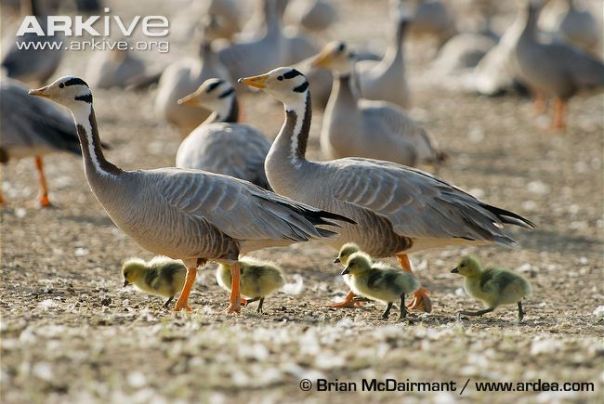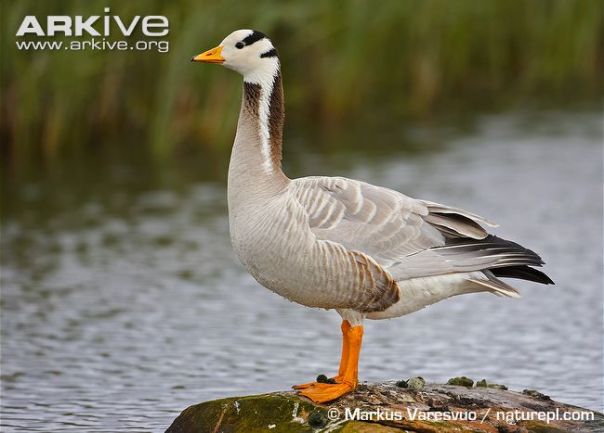- Name: Bar-headed Goose
- Latin: Anser indicus
- Classification: Bird
- Origin: Asia
- Lifespan: Up to 25 years
Taxonomy
Kingdom: Animalia (Animals)
Phylum: Chordata (Vertebrates)
Class: Aves (Birds)
Order: Anseriformes (Waterfowl)
Family: Anatidae (Ducks, geese and swans)
Genus: Anser (Geese)
Species: Anser indicus (Bar-headed Goose)
Apperance
Length: 71-76cm (28-30in)
Weight: 1.87-3.2kg (41.-7.1lbs)
Wingspan: 140-160cm (55-63in)
The bar-headed goose is characterised by the two bars of brownish-black feathers around the back of its neck. It has a light grey body and white spots on its face and neck. The bill and legs are a strong orange colour and possess webbed feet and broad wings. There is no sexual dimorphism between the male and female of this species.
Relatives
- Barnacle goose (Branta leucopsis) -LEAST CONCERN-
- Canada goose (Branta canadensis) -LEAST CONCERN-
- Egyptian goose (Alopochen aegyptiacus) -LEAST CONCERN-
- Pink-footed goose (Anser brachyrhynchus) -LEAST CONCERN-
Habitat & Distribution
The bar-headed goose lives near high altitude lakes and winters on salt and fresh water marshes. They graze in grasslands and wetlands. Most of their time is spent near or on alpine lakes.
The bar-headed goose is mainly situated in central Asia but winters to India and Burma. Their migration takes them high over the Himalayan Mountains. European populations are generally escaped captive birds.

Diet
The diet of the bar-headed goose is mainly grass, barley and rice. They will also eat paddy and corn which can cause a lot of damage to farms and gardens. Occasionally they will feed on crustaceans and invertebrates and whilst on the coats they will eat sea weeds.
The young goslings grow fast on a diet of midges during the warm summer months.
Behaviour
The bar-headed goose has one of the most amazing migrations of any animals. They migrate north from India to the Tibetan plateau to breed which takes them high over the Himalayan Mountains. They are the world’s highest flying birds and have been tracked (using GPS or satellite logging technology) flying higher than 6,540 meters (21,460ft). Their migration is taken in stages. They fly non-stop for seven hours over the Himalayas.
Reproduction
The bar-headed goose nests around lakes in dense colonies and at altitudes of up to 16,000 feet. A clutch of 4-8 eggs are laid in a shallow nest lined with the mothers down feathers. The bar-headed goose can breed at 2-3 years of age and will double clutch if the first eggs are removed. Incubation of the eggs lasts around 28-30 days and the young will fledge at 50 days. Both parents care for the goslings.
These geese will remain at the breeding grounds from late Marsh to mid-April and will leave the nesting area in late August.

Adaptations
- The bar-headed goose has a higher wing area for its weight than other geese. This helps it to glide at high altitudes.
- These geese can breathe more deeply and efficiently under low oxygen conditions. The haemoglobin of their blood can carry a lot more oxygen than other geese.
- Bird lungs have a counter exchange system which extracts O2 much more efficiently than mammals. The lungs in a bar-headed goose are much larger than in other waterfowl.
- In hypoxic conditions, the bar-headed goose can hyperventilate 7.2 times faster than their rate at sea level and suffer no ill effects.
Threats
The bar-headed goose was an early sufferer of HPAI (Highly Pathogenic Avian Influenza) and some cases are still reported today. They have many predators including crows, foxes, sea eagles and gulls and their eggs are regularly stolen by ravens. They are also hunted by humans for food, feathers and eggs.
Conservation
IUCN Status: Least Concern
More than 5,000 bar-headed geese regularly visit the Gharana Wetland Conservation Reserve in Jammu during their migration. They are also radio tracked using GPS satellite tags to map their migration routes. These are extremely lightweight and do not hinder the geese’s movements.
Fun Facts
Male: Cob
Female: Pen
Young: Gosling
Group: Gaggle, Flock
-These are the highest flying birds in the world, reaching heights of up to 20,000 feet.
-Their constant flight generates body heat which is retained in their down feathers. This keeps the goose warm while flying in the freezing temperatures of the sky.
-They are able to migrate more than 1,000 miles in a single day.
-They can fly at speeds of up to 50mph without wind to assist them.

It was great to find useful and well compiled information about bar headed geese. And also many other posts from yours. Thank you! We are working on a project for bar headed geese where this information came in handy. Will post you when we are done.
I’m glad you are finding my posts useful! Thank you for reading 🙂 xx
The male is a gander the female a goose. Cob and pen only refer to swans